Guest Post by Nina Bohn
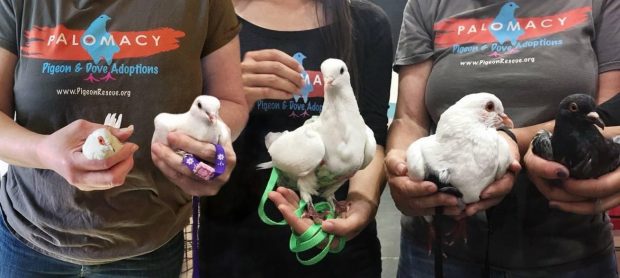
L-R: Diamond dove, Ringneck dove, Homing pigeon, King pigeon, feral Rock pigeon
Pigeon and Dove – the terms are sometimes used interchangeably, and often incorrectly. Both comprise the order Columbiformes, with over 300 species.

Rather than delve into the technical and scientific names, let’s focus on the domestic species that Palomacy primarily serves, why it’s important to distinguish them, and how they differ as pets. Depending on your location, you may see other members of the Columbidae family in your backyard – we’ll save these species for another post.
Who Do You Think of When You Hear “Pigeon”?
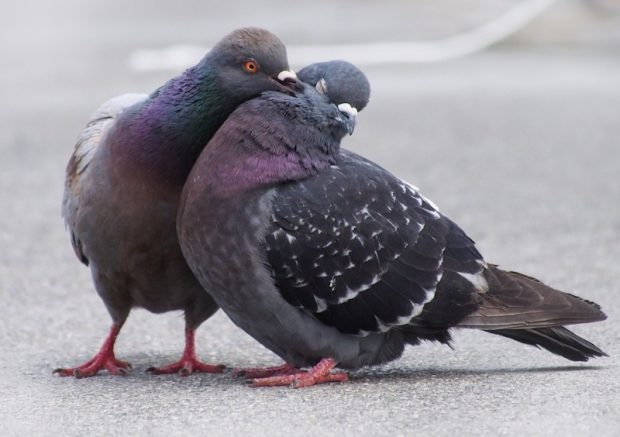
Affectionate married pair of feral Rock pigeons photographed by Ingrid Taylar
Columba Livia – The most common variety of this bird, the ‘feral pigeon’ is grey and black with an iridescent head, either a darker gray ‘bar’ or checkered pattern on its wings, and is commonly seen in parks and urban spaces where people congregate. In the US, this bird is known as a ‘Rock Pigeon’ but depending on what part of the world you live in (especially prior to British orthinologists changing it in 2004) you may refer to this well known bird as a ‘Rock Dove’ as well. They are the feral descendants of domesticated pigeons bred, over thousands of years, from the wild Columba livia native to Eurasia. They are among the earliest animals to be domesticated. There are numerous varieties and colors of domestic pigeons: All human-created breeds come from the species Columba livia, with a huge variety of traits that have been bred to the extreme (much to the birds’ detriment). Pigeons have been bred for sport, show, meat, messengers and laboratory testing and different traits are prized according to their use. Racing pigeons are bred to be exceptionally strong, fast homers. King pigeons, bred for meat, are big for maximum meat yield and white because white feathers ensure the pink skin meat consumers prefer. Many fancy breeds are trapped within bodies which nature perfected but humans have deformed- some breeds have beaks too short to feed their own young, others have feathering so extreme they can barely see or even walk, Parlor Rollers have been bred so that just opening their wings triggers somersaulting seizures.
Domestic Pigeon Breeds
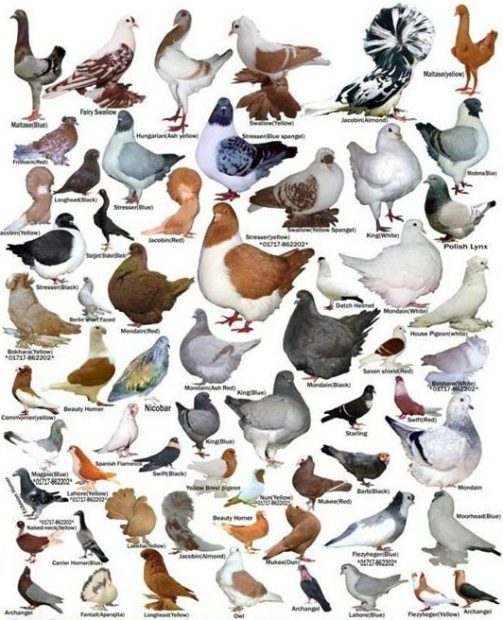
These are only some of more than 300 domestic breeds of pigeons (all are the same species- Columba livia domestica)
Are White Pigeons Doves?
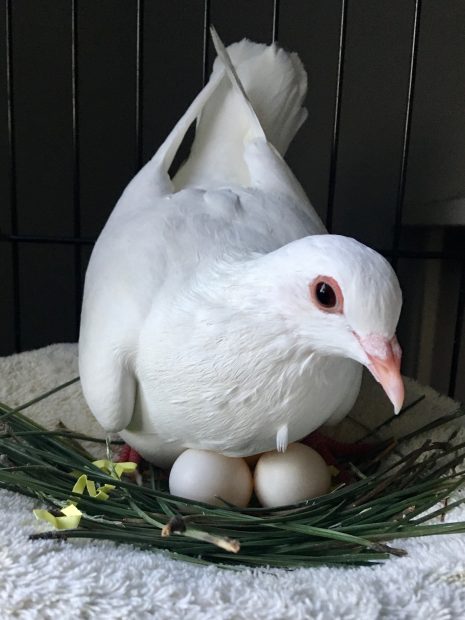
Homer pigeon Nova is a survivor of the “dove release” business rescued & photographed by Lisa Caccioppoli
No, white pigeons are domestic pigeons that the “dove release” business calls “doves” to capitalize on the positive image people have for doves while simultaneously exploiting the homing abilities of pigeons. (Domestic doves have no ability to home.) When you hear about a “dove release” or “wedding doves”, it usually means that Homing Pigeons, selectively bred to be all white, small and dove-like, were rented so as to be ceremoniously released. (They don’t call them “wedding pigeons” for some reason…)
Most will survive the flight home.
But the reality is very different from the fantasy.
The “dove release” business perpetuates the idea that white birds can be “set free” and they will just fly away and live happily ever after. Even under the best of circumstances, trained “wedding doves” are hurt, lost and killed trying to get home. It’s even worse when do-it-yourselfers mistakenly buy white Ringneck doves and King kigeons to release. Nearly all of them will die. (Read Why “Dove Releases” Are Cruel)
Doves
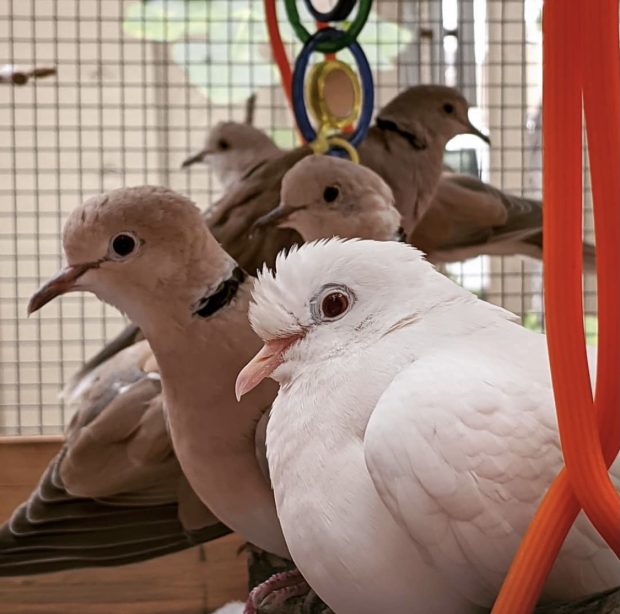
Ringneck doves (front to back) Emma, Doug, Scoop, Pekoe & Jackson fostered & photographed by Liese Hunter
Palomacy Rescues Doves Too: Ringneck doves, Eurasian Collared doves & Diamond doves.
Streptopelia Risoria – Ringneck doves are the most common species of dove kept as pets. The domestic Ringneck dove originated from the rose-gray (Rosegrisea) species of the African Collared Dove, found in north east Africa. There are several different sub-species of this bird that can be found in Eurasia, along the Arabian Peninsula and in North Africa as well. Sixteen different color varieties have been bred into Ringneck doves including all white (often mistakenly called albino). These birds were domesticated several thousand years ago and kept as pets. They are territorial and tend to form not-always-monogamous pairs. Doves are also intelligent and take excellent care of their young.
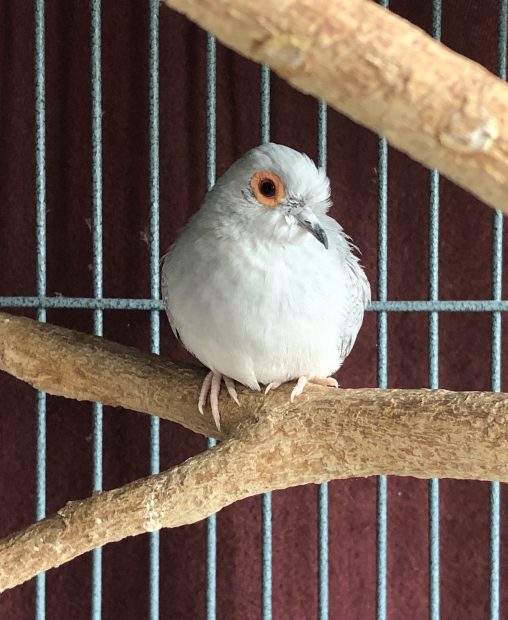
Diamond dove Ziti rescued by Nina Bohn
Pigeons & Doves
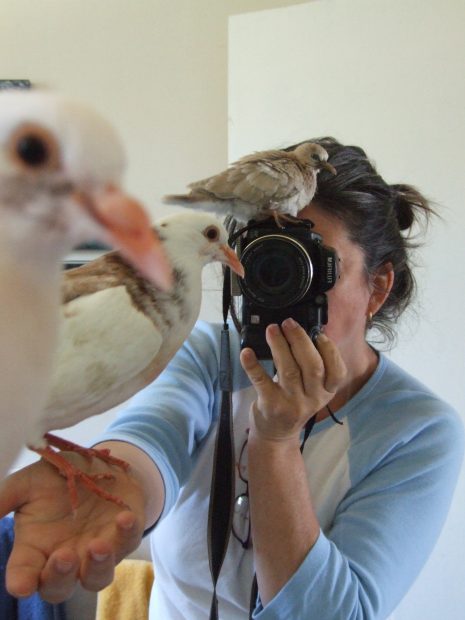
King pigeon youngster Neo in hand & Ringneck dove youngster Lily on the camera
Pigeons and doves have much in common and share many physical and behavioral similarities while also having important differences that make correct identification really important for appropriate care.
Pigeons and doves have a similar body shape with a round head, short neck, short legs, thin short beak and a stout compact body.
They both lay a clutch of two eggs with both parents taking turns spending time on the nest incubating the eggs, about 18 days on average for pigeons and 14 days for doves.
Both can produce a thick, nutritious, fatty liquid substance known as crop milk with which to feed their young in the first few days of life.
Both pigeons and doves can be territorial and possessive of their ‘space.’
Both generally maintain a monogamous relationship with one chosen mate during their lifetime, however pigeons seem to practice this moreso than doves do.
Both pigeons and doves ‘coo.’
Pigeons and Doves have similar diets consisting of seeds, grains, and fruits.
Courtship rituals are similar between the two species. Bowing, cooing, calling to the nest, wing twitching, allopreening and the deep open beak kisses are behaviors common to both pigeons and doves, with slight differences between the two.
There are some visible and some ‘not so visible’ differences between the species, however.
The most obvious difference is size. Pigeons, even the petite Roller Pigeon (weighing in at an average of 275 grams) are bigger in size than Ringneck doves (average weight around 170 grams while Diamond doves weigh only 40 grams) although there is much variance in weight and size amongst individuals. In fact, some varieties of pigeons can weigh in excess of 800 grams! Since both species are territorial, should a turf war break out, the larger pigeon can do serious damage to the smaller dove. The two species should not be housed together or left unsupervised.
Another fairly visible difference is the beak. While both species have short thin beaks, the part of the beak known as the ‘cere’, located at the base of the beak, will appear as a white powdery ‘growth’ on a pigeon whereas it appears non-existent on the dove.
There are audible differences in their vocalizations. While pigeons ‘coos’ will vary from bird to bird, one specific ‘coo’ that is universal to the feral and domestic pigeons we are familiar with is the territorial and/or mating dance ‘coo’ that sounds something like ‘rooo roooo’, a Ringneck dove’s ‘coo’ will sound more like ‘coooo ka roooo.’
There are some differences in the ‘courtship dance’ as well. A Ringneck dove will ‘bow and coo’ to his potential mate while a pigeon will sort of prance around her, often dragging his tail and cooing at her to try and get her attention.
Ringneck doves laugh, pigeons do not. That’s not to say that pigeons don’t have a sense of humor.
Pigeons have homing instincts where Ringneck doves do not.
 Nina, shown here with Ringneck dove Steve, moved to the Pacific NW in the late 90’s to attend the UW, where she dual majored in Biochemistry and Ecology. While looking at options for grad school, she took a job as a software tester, and has been working in software development ever since. Nina has worked with animals her whole life in one capacity or another but her path diverged into pigeon and dove rescue in 2014 when her son brought home a 5 day old squeaker, named Sam. Currently Nina cares for many pigeons, and various Ringneck, Eurasian Collared, and Diamond doves. In addition to bird rescue, Nina is an avid bird watcher, amateur naturalist, and nature photographer. She also enjoys reading.
Nina, shown here with Ringneck dove Steve, moved to the Pacific NW in the late 90’s to attend the UW, where she dual majored in Biochemistry and Ecology. While looking at options for grad school, she took a job as a software tester, and has been working in software development ever since. Nina has worked with animals her whole life in one capacity or another but her path diverged into pigeon and dove rescue in 2014 when her son brought home a 5 day old squeaker, named Sam. Currently Nina cares for many pigeons, and various Ringneck, Eurasian Collared, and Diamond doves. In addition to bird rescue, Nina is an avid bird watcher, amateur naturalist, and nature photographer. She also enjoys reading.
Bonus Content
by Pam Thompson, Palomacy Help Group Member
Domesticated “Rock pigeons” are classified as Columba livia domestica. Domesticated “Ringneck doves” are currently classified as Streptopelia risoria. Rock pigeons and Ringneck doves are two separate species classified into two separate genera. In the context of this group, “pigeon” almost always refers to the domestic Rock pigeon (Columba livia domestica), and “dove” almost always refers to the domesticated Ringneck dove (Streptopelia risoria). As noted in the original post by Nina, these are different species with different behaviors and different care requirements!
Rock pigeons that are pure white are often called doves, and they may be mistaken for white Ringneck doves. Many breeders purposefully refer to white Rock pigeons as “doves”. White Rock pigeons are not the same as white Ringneck doves! Nina has some really great info in the original post about how to tell the two apart.
When it comes to how birds in the family Columbidae receive their common names, I don’t think there is any pattern determining what gets called a pigeon and what gets called a dove. For example, why are birds in the genus Leucosarcia given the common name “Wonga pigeon”? Why are birds in the genus Macropygia given the common name “Cuccoo dove”?
If anyone wants to go down the rabbit hole and explore the many MANY species and subspecies of birds in the Columbidae family, here is a good place to start:
https://animaldiversity.org/accounts/Columbidae/classification/#Columbidae
The Rock pigeon species contains several subspecies (not just the domesticated subspecies we are familiar with) depending on where the birds live. There are no subspecies of Rock pigeon that are native to North America. As far as I can tell, the feral pigeons living in North America are still classified as Columba livia domestica, the domesticated Rock pigeon. Despite this classification, feral Columba livia domestica are not always reliant on human cities for survival. Last year I was privileged to observe a feral Rock pigeon colony living among cliff formations in eastern Oregon, far from any large cities or towns. They were wild birds, for all intents and purposes.
The common name “Rock pigeon” was previously “Rock dove”, because all of this wasn’t confusing enough. Around 2004, British ornithologists decided to change the name to Rock pigeon, and America soon followed. There is a movement to change the name back to Rock dove, but it has not been successful so far.
https://www.museum.lsu.edu/~Remsen/SACCprop109.htm
https://www.audubon.org/news/we-should-definitely-call-pigeons-rock-doves-again

